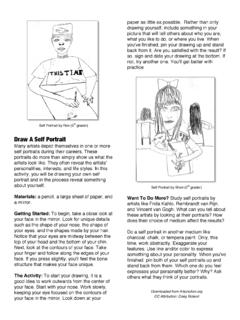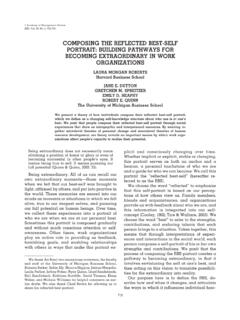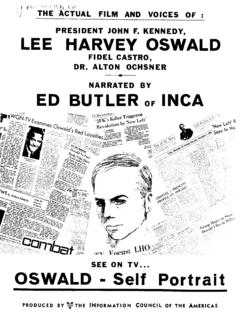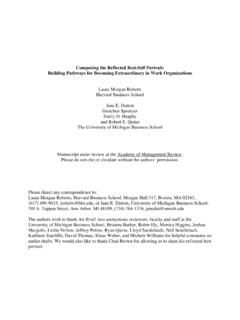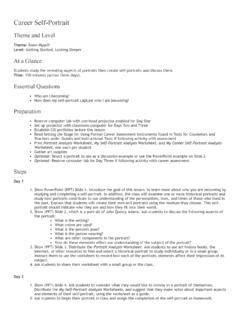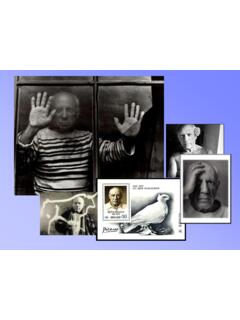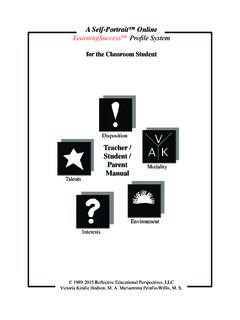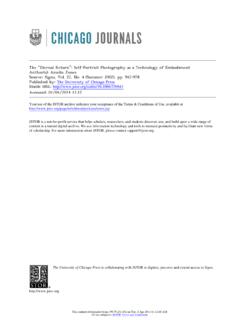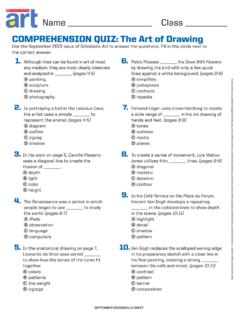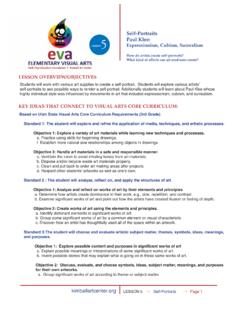Transcription of “Face-to-Face”With Addiction: The Spontaneous Production ...
1 Art Therapy: Journal of the American Art Therapy Association, 24(1) pp. 33-36 AATA, Inc. 200733 AbstractIn this brief report, two examples are presented of self -portraits spontaneously produced by chemically dependentpatients who participated in art therapy while in an acuteinpatient psychiatric hospital. The author concludes that self -portraits provide true-to-life representations of the diseasedaspects of the self and enable patients to confront their addic-tive the chemically dependent person is the last torecognize that he or she has an addiction. This lack ofawareness is commonly referred to as denial. As an integralpart of the disease process, denial allows the individual toeither disavow or distort variables associated with his or heraddiction in spite of evidence to the contrary (Kaufman,1994; Stevens-Smith & Smith, 1998). It is a defense mech-anism whereby chemically dependent individuals can avoidfacing painful realities and the consequences of their addic-tive causes a person to construct a self and world-view that is harmonious with the preservation and continuedprogression of the addiction.
2 Consequently, addiction ren-ders difficult if not impossible the experience of a self and aworldview incongruent with its objectives. The process ofaddiction eventually transforms the worldview of the addict-ed individual and even realigns the person s sense of self so asnot to impede the advancement of the disease (George,1990; Springham, 1999; Winship, 1999).Denial creates a major obstacle to recovery and is fre-quently a precipitous factor in relapse events. The addic-tion cannot be effectively addressed until the individualacknowledges its existence (Perkinson, 1997; Waller &Mahony, 1999). The chemically dependent individual canhave various levels of insight and readiness to alter world-views or sense of self (Stevens-Smith & Smith, 1998;George, 1990).Art therapy can often assist a chemically dependentindividual to work through defense mechanisms that dis-tort his or her sense of self and life (1990) wrote that a Spontaneous frontal por-trait often implies the need to recognize and accept some-thing that is difficult to acknowledge.
3 Dalley, Rifkind, andTerry (1993) agreed and stated that a self - portrait may rep-resent the individual s need to face up to something diffi-cult to accept. Hammer (1967) argued that a full frontalportrait possibly indicates the individual is ready to con-tend with reality and to confront painful truths that mayalter his or her occasion, self -portraits are spontaneously pro-duced by chemically dependent patients during the courseof art therapy. My clinical observations have shown me thata Spontaneous frontal self - portrait often reflects the indi-vidual s effort to come face-to-face with his or her addictivenature. The self - portrait is a true-to-life representation ofthe individual s addictive practices. Often it is a candidreflection that refutes the individual s false sense of self anddistorted worldview. Thus, self -portraits enable the chemi-cally dependent individual to confront painful realities andto acknowledge the ill effects of his or her ExamplesThe following examples were obtained from individu-als participating in group art therapy in an acute inpatientpsychiatric hospital.
4 Group membership changed as pa-tients were discharged and new individuals were group was not homogeneous and included peoplewith a variety of psychiatric diagnoses. It was mandatoryfor all patients to participate in art therapy. Time was pro-vided at the end of each session for patients who wished toshare and discuss their individuals participating for the first time wereshown around the art studio and oriented to the variousmaterials, storage spaces, and so on. The studio wasstocked with art materials and had a sink, places to sit, andtable space. Typically, a non-directive approach wasemployed in the sense that participants were provided avariety of art media and encouraged to use these materialsaccording to their own choices and (pseudonym) was a 50-year-old Caucasian malehospitalized for a depressive episode and recent alcoholbinge. He was divorced and had two children.
5 At the timeof his hospitalization, he was living with his mother whomhe described as domineering and controlling. Bob hadsought treatment for his alcohol addiction several times in Face-to-Face With Addiction: The SpontaneousProduction of self -Portraits in Art TherapyMichael J. Hanes,Edmond, OKEditor s note:Michael J. Hanes, MAT, ATR-BC, LPC, isDirector of CQI at Red Rock BHS and an art therapist at theOklahoma County Detention Center. He is an adjunct facultymember at Oklahoma State University and guest lecturer at theUniversity of Oklahoma. Correspondence concerning this articlemay be sent to the author at past; however, his sobriety was always short lived. Hefailed to recognize the severity of his alcoholism andbelieved he could control his drinking. Bob was hospital-ized for five days, during which time he attended two arttherapy his initial session, Bob was withdrawn and remainedon the periphery of the group.
6 He expressed intense misgiv-ings regarding the art process and was hesitant to engagewith the art materials. Despite encouragement and supportfrom group members and me, Bob watched passively andremained silent during the group discussion. In his second session, Bob continued to experience self -doubt and reluctance. I employed the scribble technique to help him reduce his inhibitions and to facilitate his pro-duction of Spontaneous imagery (Cane, 1983; Hanes,1995). Bob performed the scribble in a rigid and self -imposed manner, demonstrating his reluctance to relinquishcontrol. He was encouraged to view the shapes and formsbrought about by the intersecting lines with the expectationof discovering some approximation of an I rotated the scribble to adjacent sides, Bob discov-ered a semblance of a face. I then encouraged him to devel-op the image further by adding and removing additionallines.
7 Bob identified the contorted face as a portrait of him- self . He described the portrait as being one hell of a drunk. The portrait stares out from the paper and may have illus-trated his need to face his addictive practices, which untilthen he had been unable to renounce (Figure 1).The image was true-to-life and provided a genuinerepresentation of his addictive nature. Through his self - portrait , Bob came face to face with his alcoholism. That swhat I look like when I m drinking, uttered Bob. He fur-rowed his brow and stated, I don t like what I see. Again, I rotated the scribble and encouraged Bob tofind some semblance of an image. In the center of hispaper, Bob discovered the visage in Figure 2. He stated, Itis a man wearing a blindfold and he is frowning. Theblindfold may have represented his denial, which cloakedhis eyes from the truth, thus thwarting his ability to see theworld as it truly was.
8 I don t want to see my problem, stated Bob. The portrait seemed to convey a sense of help-lessness and anguish. Bob acknowledged, I am a hostageto my addiction. His denial had kept him in the dark andheld him captive to his addictive figure appears to be squeezed between two breast-like shapes which may represent Bob s oral dependence aswell as his mother s stifling dominance. Bob discussed hisreliance upon his mother whereby she was able to assert hercontrol and influence. My mother is smothering me, asserted Bob. Bob s brief hospitalization permitted only two art ther-apy sessions, yet his impromptu self - portrait was instru-mental in helping him come face to face with his addictivenature and begin confronting his denial. I have to startdealing with my drinking. I don t like what I ve become, stated Bob. His self - portrait enabled him to recognizepainful realities that would ultimately alter his being released from the hospital, he remained com-mitted to treatment and began attending AlcoholicsAnonymous and outpatient (pseudonym) was a 23-year-old Caucasian malehospitalized for polysubstance dependence.
9 He was mar-ried and had one child. Although Kevin volunteered fortreatment, he said he felt coerced by his family and believed he had lost his job unfairly and that he did nothave a drug or alcohol problem. Kevin was unwilling torecognize his addiction and the need for treatment. He washospitalized for 7 days, during which time he attended twoart therapy his initial session, Kevin engaged in the art processwithout hesitation. He used a pencil and a sheet of 12" x18" paper to draw the image in Figure 3. Kevin created acinder block wall that spans the page. Throughout the wallimage, he intermittently placed syringes and a marijuanaleaf. Kevin laughed and announced to the group, This ismy addiction. The fortified wall also may have represent-ed his attempt to defend and protect himself. Cooper(1978) identified walls as symbolic of providing shelter yet34 FACE-TO-FACE WITH ADDICTION: THE Spontaneous Production OF self -PORTRAITS IN ART THERAPYF igure 1 Figure 235simultaneously placing limitations.
10 Portions of the wallappear to have collapsed, suggesting that Kevin s defensesmay have been drew a likeness of himself emerging frombehind the wall (Figure 4). The figure is displaying its mid-dle finger, suggestive of hostility and an anti-social above the figure is a cinder block that is block reads, wake up dumb ass and suggests thatKevin needs to become conscious of something. Kevin stat-ed, I guess I need to get hit over the head. Maybe then Iwill deal with my drug problem. In his next art therapy session, Kevin used pencil and12" x 18" paper to draw the frontal portrait in Figure Bob, Kevin s portrait stares out from the page. Theeyes are vacant, creating a mask-like appearance that sug-gests his unwillingness to view the environment or toabsorb what it has to offer (Oster & Montgomery, 1996).The eye without a pupil suggests an unseeing eye (Hammer, 1967).










